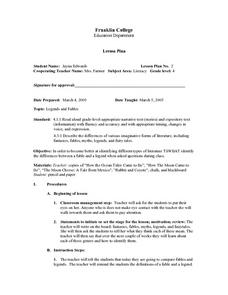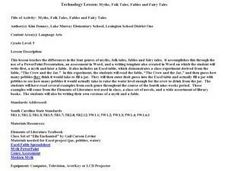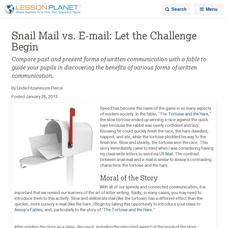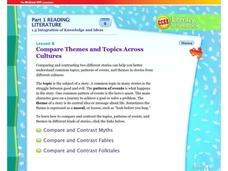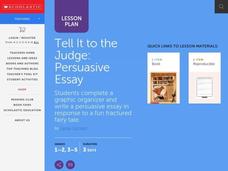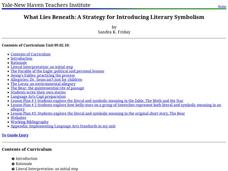Curated OER
Fables Unit Lesson Plan
Students study fables in a broad context. In this literary lesson on fables, students define terms unique to them. Students use a variety of technological resources to gather and classify information into three categories. Students also...
Curated OER
Fable for Tomorrow and Today -- Rachel Carson's Silent Spring
Students read Rachel Carson's "Silent Spring". They identify their beliefs about the environment while reading the story. They discuss and write about those beliefs and realize how one person can have an impact on the world.
Scholastic
Folk and Fairy Tale Readers: The Three Little Pigs
Engage young learners in developing their reading fluency with their very own copy of The Three Little Pigs. Including a series fun illustrations, children will have a hard time putting this book down.
Curated OER
Writing a Fable
Students are introduced to the definition of a fable in that it is a story that has a moral for people to apply in their lives. They then read a fable together so they have a better understanding. Next, students write their own fables.
Curated OER
Fable Writing--Inter-disciplinary Approach To Social Sciences
Students recognize the elements of a fable and write an original fable. They make connections with morals and other law-related concepts.
Curated OER
Fantasy, Fables, Myths, Legends & Fairy Tales
Students identify the differences between fantasies, fables, myths, legends and fairy tales. In groups, they create their own versions of the different genres. They practice identifying the examples, as well.
Curated OER
Kindness Fables
Young scholars create a fable that is based on kindness. In this fables lesson plan, students read and discuss different fables. Then they discuss kindness, and write their own fables based on the kindness of others.
Curated OER
Greek culture and Aesop's Fables
Tenth graders explain political and social thought during the Greek 6th and 5th centuries B.C. They research five to eight fables, figuring out the moral for each and writing an essay on how Aesop influenced the morals and ideals of...
Curated OER
Is That a Fact? A Comment on Modern Fables
Students complete literary analysis for modern fables or urban legends. In this modern fables lesson, students listen to an urban legend and discuss it. Students then research urban legends online and write their own urban legend.
Curated OER
Legends and Fables
Fourth graders identify and discuss the differences between legends and fables. They define fable and legend, then as a class take turns reading our books. Students select two of the stories, and complete a Venn diagram, comparing one...
Curated OER
Secret Stories: Exploring the Elements of Folktales and Fables
Students are introduced to the characteristics of fables and folktales. In groups, they read and identify the various elements in the stories they read from around the world. For each story, they analyze the setting and the various...
Curated OER
Fearless Fables: The Sheep And the Pig
In this reading comprehension worksheet, students participate in reading a fable about some animals who are building a home of their own. This fable has a clear moral presented. There are no questions on the page.
Curated OER
Fearless Fables: The Lion And the Mouse
In this reading comprehension worksheet, students participate in reading a classic fable about a lion and a mouse. There are no questions on the page.
Curated OER
Myths, Folk Tales, Fables and Fairy Tales
Fifth graders study the differences in the four genres of myths, folk tales, fables and fairy tales. They use a PowerPoint Presentation, an assessment in Word, and a writing template also created in Word on which they write first, a...
Curated OER
Lots of Lessons from Aesop
Aesop’s Fables offer young learners an opportunity to study figurative language. After reviewing theme, simile, alliteration, and metaphor, model for your pupils how to identify examples of these devices in the fable. Class members then...
Curated OER
Elements of the Oral Tradition
Various genres of oral tradition are outlined and defined in these slides. Give your class examples of folk tales, fairy tales, parables, fables, legends, and myths before reading an example of one of these stories. This overview acts as...
Curated OER
Hard C and Soft C
Learners categorize different words that contain a hard c and a soft c. In this hard and soft c lesson plan, students also pick words from each of the categories and write a story with those words.
Curated OER
Snail Mail vs. E-mail: Let the Challenge Begin
Compare past and present forms of written communication with a fable to guide your pupils in discovering the benefits of various forms of written communication.
McGraw Hill
Compare Themes and Topics Across Cultures
Compare and contrast folktales, myths, and fables in an interactive eBook. The interactive is broken up into three topics: myths, fables, and folktales. Each section includes a reading passage and a guided lesson on the theme, topic, and...
Curated OER
Greek Culture And Aesop's Fables
Pupils investigate Aesop's Fables and how they influenced the culture of Ancient Greece. They research five different fables and reflect upon the morals of the stories and state how they influenced the practices of the Greek in writing.
Curated OER
Literature Response for Home-School Connections: Fables
First graders participate in home and school based literacy activities in this unit. They examine fables in school and practice the literacy activities at home.
Curated OER
Tell It to the Judge - Persuasive Essay
Students compare and contrast a classic fairy tale with a fractured one and complete a graphic organizer. Then they write a persuasive essay following the steps of the writing process. Finally, students publish their completed essay and...
K5 Learning
Androclus and the Lion
Kindness is never a standalone act. Fourth graders read the classic tale of Androclus and his act of service to the lion, which is repaid to him by the lion in a Roman colosseum. After reading the passage, they answer four comprehension...
Yale University
What Lies Beneath: A Strategy for Introducing Literary Symbolism
“It’s not about what it is, it’s about what it can become.” You’re never too old for Dr. Seuss and using The Sneetches and The Lorax is a great way to introduce readers to allegories, parables, and literary symbolism. The lessons...
Other popular searches
- Writing Fables and Folktales
- Writing Fables Middle School
- Writing Fables 4th Grade
- Writing Fables Grade 6
- Writing Fables Mind Map
- Writing Fables Gr 5
- Writing Fables Rubric
- Writing Fables Gr 2
- Writing Fables Animal Farm
- Writing Fables Gr 3
- Aesop's Fables and Writing
- Fables Six Traits Writing











